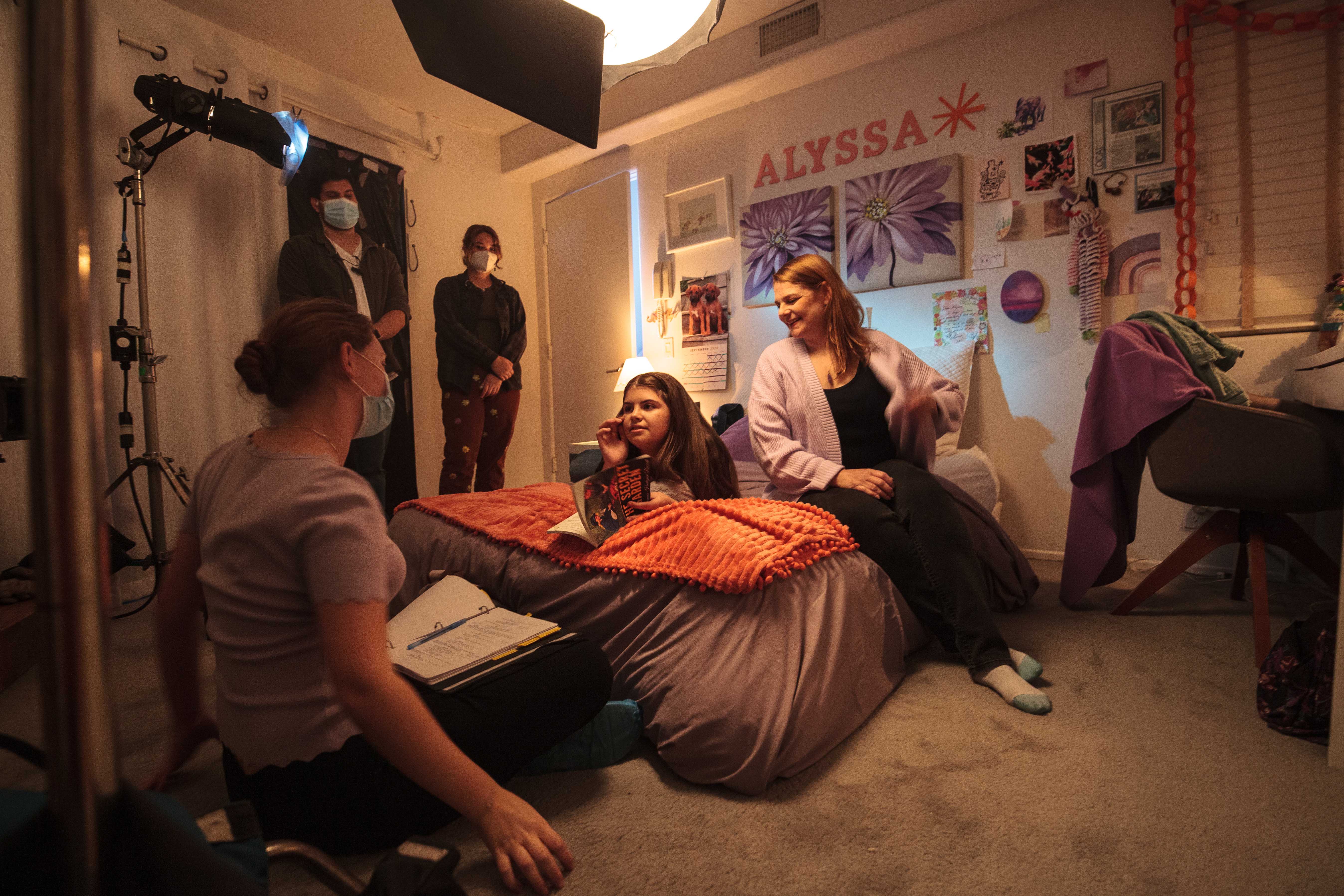Alumnus examines divorce through a child’s eyes in thesis film ‘Purple and Green’

Alumnus Charlotte Oxley directs actors Carrie Lynn Certa and Mackenzie Grace Gilligan for her thesis film, “Purple and Green.” The short film portrays divorce through a child’s perspective, Oxley said. (Courtesy of Claudia Hoag/Charlotte Oxley)
By Puja Anand
June 29, 2023 3:31 p.m.
This post was updated July 23 at 5:27 p.m.
Charlotte Oxley is forging a new outlook on divorce in her thesis film.
Winning the UCLA Dean’s Prize for Excellence in Research and Creativity, the alumnus’ short film “Purple and Green” strives to portray divorce through a child’s perspective, she said. As a child of divorce herself, Oxley said her film deeply connects to her own experiences growing up and the struggles of her peers who also had separated parents. Though approximately 50% of children face their parents’ divorce, there is minimal representation of these experiences in film and television, thus driving Oxley to create the project and showcase the reality of divorce, she said.
“Just the fact that so many children and people go through this, and it’s such an impactful life event, and it’s not really shown from the perspective of when it happens, … I think just drove home the point that I wanted to make something like this,” Oxley said.
[Related: UCLA student examines grief, family dynamics in film “I’ll See You in My Dreams”]
With a script developed in the summer of 2022, Oxley said the film follows two sisters who lean on each other through the stress and anxiety of maneuvering a divorced household. The title, “Purple and Green,” symbolizes this exact divorced experience – the colors mark the sisters’ custody schedule on their shared calendar, Oxley said. To reinforce this theme, the color palette for each parent reflects the title, she added: The mom’s home is accessorized in tones of purple while the dad’s house displays green hues. These underlying cues in the production design lend themselves to a child’s simplified lens on such complex subjects, Oxley said.
Visuals aided the film’s themes in several other ways, Oxley said, with cinematography emphasizing the sisterly dynamics she wanted to display. For instance, contrasts between high and low shots symbolized the disparity between the children and their parents, Oxley said. This was furthered by a conscious inclusion of both sisters in a single frame, which she said demonstrated the implicit bond and feeling of unity they shared. Alumnus Jackie Fang, the film’s director of photography, said their deliberate departure from artificial lighting served to highlight the authentic tone of the film.
Another key aspect of Oxley’s film is the research aspect – a natural byproduct of her cognitive science minor, she said. While researching during the screenwriting process, Oxley said she discovered that children of divorce are more susceptible to health issues, both physically and mentally. With this in mind, Oxley was surprised to find negligible portrayal of such psychological realities on the screen, propelling her to present her film as an amalgamation of research and media. Producing graduate student Marion Adou said Oxley’s passion for research built a strong foundation for the film and grounded its message.
Since divorce and separation are difficult topics to discuss, Oxley said many people shy away from reading papers on its effect on children. Hence, film was an ideal platform to flesh out this discourse and build awareness in a relatable, intuitive manner, she said. From visual breakdowns to palpable health concerns, the film aims to address the impact of a child’s physical environment, specifically tension in their upbringing, on their body and mind, Oxley said. Expressing brutal ideas of childhood struggles through symbols and subtle hints in the shooting style made for a child-friendly take on the delicate subject of divorce, she said.
“A lot of people might not want to just read an article about how divorce affects your life, but showcasing it in a hopefully entertaining film that you’re able to resonate with and is sad and funny and hopeful – people who even might not have the experience of divorce get a sense of what it might be like through the visual medium,” Oxley said. “(This) is one of the coolest things about film: You’re able to tell a story visually and auditorily.”
[Related: Graduate student Jahmil Eady brings social issues to screen with short films]
Working with minors was a sizable obstacle in the filmmaking process, Oxley said, since their strict working hours, school times and bandwidth to act had to be respected. Though several people discouraged her from enlisting minors as actors, Oxley said this was necessary to keep the integrity of the child’s perspective within “Purple and Green” intact. Noting the film’s familial team attitude, Adou said her biggest takeaway from being a contributor was the role and value of every member in the film’s success.
Given that Oxley was drawing from sensitive, personal experiences, Fang said she admired her vulnerability while visualizing a concept that hit so close to home. Adou added that Oxley’s own background pushed her to not just portray but also understand the subject in a raw, emotional way. Watching Oxley come to terms with her past and create this piece as an ode to others going through the same experience was inspiring, making her the right person to tell this story, Fang said.
“Seeing Charlotte coming out from her childhood trauma is kind of similar to what the film wants the audience to feel,” Fang said. “Yes, maybe sometimes as a kid you’re put in a situation that you can’t really control, but … you can still choose to become who you are – whoever you want to be in the future.”
The film has been a huge step in her future as a filmmaker, Oxley said. Moreover, the film is a model for the work she said she wishes to pursue: grounded stories narrating true-to-life, genuine realities. In light of the film’s heavy themes, Fang said she hopes it provides children and adults watching it with a positive perspective on divorce, leaving them with the comfort that, despite their difficulties, they are loved and cared for. If the film makes the audience feel seen regardless of their own connection to divorce and comes across as a believable, realistic story, it will have achieved its purpose, Oxley said.
“There’s aspects about just dealing with emotional situations and difficult situations that a wide audience would … still resonate with,” Oxley said. “That’s really all I could ask for as a director, is for an audience to relate to the film and to see themselves in it.”


